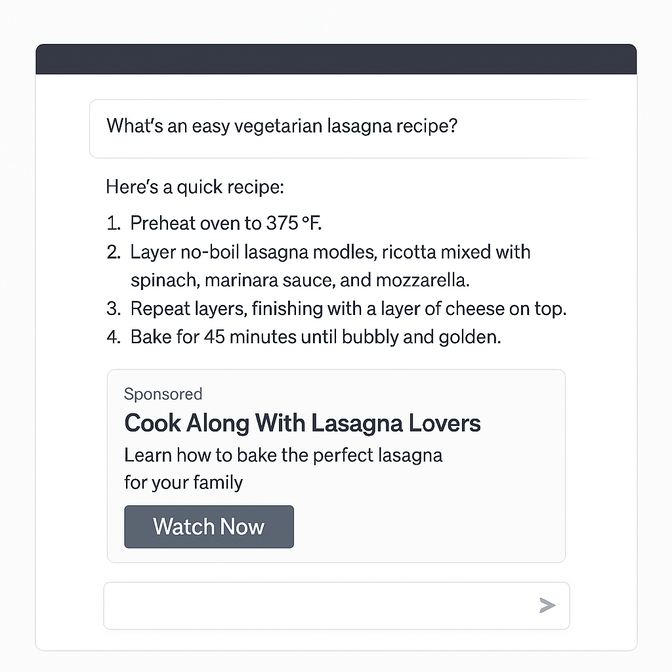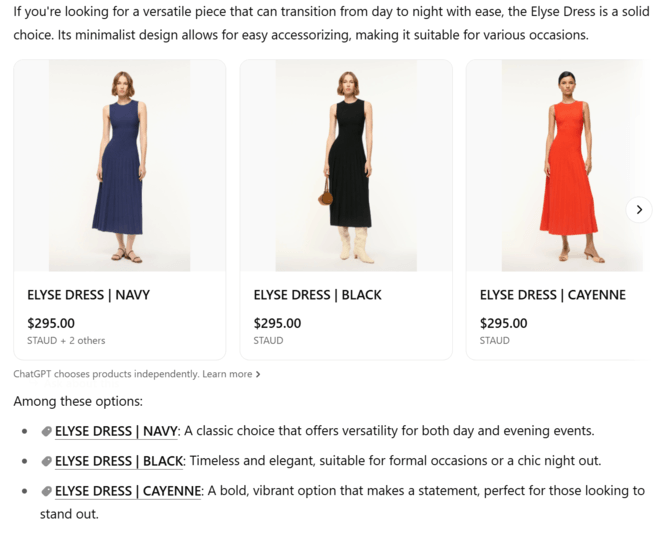Key Takeaways
-
ChatGPT advertising is OpenAI’s plan to monetize its free users by introducing sponsored content inside the platform, including ChatGPT Pulse.
-
Currently in development, ads are expected to roll out around 2026 and could generate billions in revenue by 2029.
-
Ad formats may include sponsored links, product suggestions, or short sessions that unlock extra features.
-
Costs will likely follow familiar models, such as pay-per-click or pay-per-view, but exact pricing is still unknown.
-
Early adopters stand to benefit, with access to ChatGPT’s massive audience, less competition, and the chance to build brand visibility before ads become mainstream.
What is ChatGPT advertising?
ChatGPT advertising is OpenAI’s upcoming way of monetizing its free user base by displaying sponsored content within the platform. While still in development, ads are expected to roll out as early as 2026, with OpenAI projecting nearly $25 billion in revenue from this channel by 2029.
Unlike traditional ad networks, ChatGPT ads will likely focus on transparency and personalization, offering formats like contextual recommendations, embedded links, or sponsored sessions. For businesses, this represents a chance to reach ChatGPT’s massive 800+ million weekly active users with hyper-targeted, AI-driven campaigns.
How these ads will look — and how much they’ll cost — is a mystery, but with OpenAI hiring advertising veterans from Google, Meta, and X, we can guess. Discover the future of ChatGPT advertising and how to prepare for its launch now!
- What is ChatGPT Advertising?
- Where is ChatGPT Advertising Now?
- What Will Ads Look Like on ChatGPT?
- How Much Will ChatGPT Ads Cost?
- How Will ChatGPT Ad Auctions Work?
- Who Should Advertise on ChatGPT?
- Is ChatGPT Advertising Worth It?
- How Can I Appear on ChatGPT Without Advertising?
Where is ChatGPT advertising now?
In development.
Here is what we know so far about ChatGPT advertising:
- OpenAI forecasts $1 billion in new revenue from free user monetization (starting in 2026) and predicts that in the next four years (read 2029) this outlet will generate nearly $25 billion in revenue — just $4 billion less than its enterprise-level AI agent service
- CEO Sam Altman has referred to ChatGPT ads as a “last resort” while CFO Sarah Friar has stated the company plans to be “thoughtful” about where and when ads will appear on the platform
- The company generates between $3.5 and $4.5 billion in revenue annually but spends more than $8.5 billion. Analysts predict the company will post a $5 billion loss over the next 12 months — and won’t see a profit until 2029.
- OpenAI has recently hired several C-level executives who all have an impressive pedigree from ad tech teams at X, Meta, Instagram, and Google.
- The company started hiring in September 2025 for a “Growth Paid Marketing Platform Engineer,” whose responsibilities will include “developing campaign management tools” and contributing to the “long-term growth of ChatGPT by building the technical infrastructure behind OpenAI’s paid marketing platform“.
While ChatGPT has grown dramatically since its launch (its number of weekly active users tops more than 800 million), the time is now for OpenAI to lay the groundwork for making its platform profitable. And one of the most effective outlets for this is advertising.
Just ask Google about its number 1 source of revenue.
What will ads look like on ChatGPT?
Based on what we know, we can assume the following about ChatGPT ads:
- Transparency: Altman is not a fan of advertising, having stated, “I kind of hate ads…I like that people pay for ChatGPT and know the answers…are not influenced by advertisers.” As a result, we can assume ChatGPT ads will have clear sponsorship indicators.
- Personalization: From memories to custom instructions, ChatGPT is all about personalization. With historical data, plus contextual information from chats, the platform will have the means to create hyper-personalized ads.
What these ads will look like is a mystery, though there are several valid options to consider, like:
| Format | Function |
| Contextual | Ads woven into an AI’s written response, such as, “Based on your interest in sustainable travel, you might consider EcoTours (Sponsored) for your upcoming trip.” |
| Embedded | Ads similar to search engine and Microsoft Copilot ads, which appear as sponsored links before or after the engine’s response. |
| Sponsored session | Ads users watch, listen to, or interact with for an uninterrupted ChatGPT session or additional tokens, like for Deep Research. Spotify uses this ad format for its free tier. |
| Carousel | A carousel for local- and ecommerce-based discussions, like “Based on the event and your style, here are some possible outfit options.” |
| Premium feature session | Similar to a sponsored session, users would watch or listen to ads to unlock premium features from ChatGPT’s Pro plan. |
For fun, here’s a mockup of what an ad could look like in ChatGPT:

How much will ChatGPT ads cost?
Businesses can expect ChatGPT advertising to use a pricing model similar to other networks, like:
- Google Ads
- Microsoft Advertising
- Meta Advertising
- Spotify Ads
How much these ads will cost, whether charged by impressions, clicks, transactions, or something else, is unknown. If the auction process is similar to the above ad networks, though, businesses could see lower costs due to less competition and amplified targeting options.
Based on OpenAI’s opening for a Growth Paid Marketing Platform Engineer (which mentions developing the necessary pipelines and services to support spend optimization), it’s likely the company wants to provide tools similar to other platforms for optimizing objectives, like visibility, traffic, leads, or purchases.
How will ChatGPT ad auctions work?
Based on its job openings and team of advertising veterans, which ranges from Google to X, we can guess ChatGPT will re-use some familiar ad functions. Besides being proven, these advertising features are also familiar to advertisers, which can help with adoption:
- Audience targeting, such as customer lists, plus demographic and psychographic data
- Bidding models, like CPM, CPC, and CPL
- Ad quality, like through user feedback, actions, and conversion rates
- Reporting, such as measuring impressions and return on ad spend (ROAS) in real-time
It’s likely ChatGPT’s advertising platform will also integrate with other ad platforms. Based on its job listing, OpenAI’s Growth Paid Marketing Platform Engineer role “will include projects such as…integrating with major ad platforms.”
Similar to other tech companies, like Meta, it’s possible ChatGPT will incorporate AI to help advertisers create more compelling advertising assets, from visuals to copy to offers, similar to Google’s use of artificial intelligence in Google Ads.
Who should advertise on ChatGPT?
Companies whose target audience overlaps with ChatGPT’s should consider advertising there. The platform’s biggest audience (54-57%) is users between the ages of 18-34, which aligns with our findings on how different generations search.
That doesn’t mean companies targeting an older audience should skip ChatGPT ads.
There is a real advantage to being an early adopter of new — and fast-growing — marketing and advertising channels. With less competition in the space, early adopters can get more exposure (along with a lower acquisition cost).
Plus, with less competition, advertisers could see lower advertising costs than on more saturated networks, like Google Ads or Meta Advertising. Not to mention, businesses have the chance to dominate paid advertising opportunities while other companies hold off on advertising.
Is ChatGPT advertising worth it?
Yes.
While that answer seems premature since ChatGPT ads haven’t launched, our answer comes from the value our clients (and even our agency) have seen from being organically mentioned or cited in ChatGPT responses.
These organic mentions and citations have helped our clients generate the following:
- Brand awareness
- Website traffic
- Leads
- Sales
You can see these wins in-action for a few of our clients below:
| Business Industry | Results |
| Manufacturing (View Case Study) |
|
| Heavy equipment (View Case Study) |
|
These results mimic what companies see from investing in search engine optimization (SEO) and paid advertising on platforms like Google, Bing, and DuckDuckGo. The visibility — and relevance — results in measurable (and impactful) results for a business.
So, even though ChatGPT ads haven’t launched, the data shows it’ll be a worthwhile investment.
How can I appear on ChatGPT without advertising?
You don’t have to wait for ChatGPT ads to get your business listed on the platform. ChatGPT already mentions brands and cites its sources, allowing users to learn more about a company by clicking a link to view products, read guides, book appointments, and more.

Getting featured in ChatGPT’s responses happens through OmniSEO®, which includes:
These optimizations include a range of strategies, like:
- Making a website accessible to search and answer crawlers
- Producing content with a unique angle, specific insights, and visuals
- Optimizing content with key phrases, structured data, tables, and more
- Getting cited on third-party websites, whether via linked or unlinked mentions
You can dig into this approach in our guide on how to rank in ChatGPT responses.
Get visibility now — not later — with OmniSEO®
You don’t have to wait for ChatGPT advertising to start benefiting from the platform.
With OmniSEO, it’s possible to generate awareness, traffic, and revenue from ChatGPT and other AI platforms, from Perplexity AI to Gemini. And with more than 700 successful campaigns completed, WebFX (the team behind SEO.com) is a partner proven to meet the challenge.
Connect with us today to start appearing in ChatGPT responses!

Grow Your Visibility Beyond Google
Capture leads and traffic from emerging search platforms like ChatGPT, Perplexity, and Google AI.



Grow Your Visibility Beyond Google
Capture leads and traffic from emerging search platforms like ChatGPT, Perplexity, and Google AI.

Grow Your Visibility Beyond Google
Capture leads and traffic from emerging search platforms like ChatGPT, Perplexity, and Google AI.
What to read next
- Oct 24, 2025
- 7 min. read



